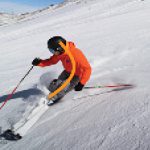Understanding angulation and inclination is key to controlling your skidding.
One of the main reasons people sign up for a ski lesson is because they have trouble gripping on hard or icy snow. The solution to this anxiety-inducing sideways sliding is to develop effective edging.
The majority of skiers intuitively understand that tipping their skis farther up on edge somehow results in more grip. And for the most part, they’re right. Provided the edge of the ski is adequately sharp enough to penetrate the snow surface, it should, in theory, create a solid platform if held perpendicular to the force applied to it. The complicated bit is that last part: how the force is applied to it. Not only does this mean that the working ski has to stay tipped adequately up on edge, but the skier’s balance also needs to remain predominantly through the middle of it so the force is applied in the right direction. This inseparable combination of balance and edge control requires precise lateral moves.
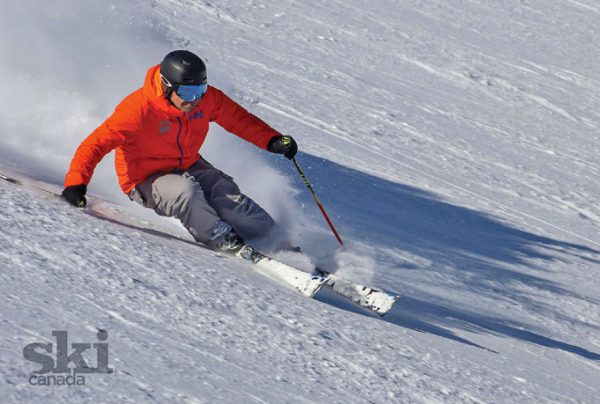
Some edging just happens
Every skier naturally leans into a turn. We call this “inclination” and it’s absolutely necessary to balance against the momentum pulling your mass toward the outside of the arc. If you don’t do this, you’ll rag doll head over heels down the rest of the pitch. So the wonderful balancing properties of inclination are a good thing—but there’s more. Inclination also comes packaged with the added benefit of tipping our skis on edge.
Sadly for us skiers, too much of a good thing usually has undesirable consequences. Just like overdoing an Austrian après session, excess inclination may cause you to fall over, or at the very least, it will shift balance to the inside ski. Either way, the outside ski releases its delicate hold on the snow…and the dreaded sideways slipping resumes.
The speed you’re travelling and the radius of the arc limit the amount you can lean into a turn without losing your balance. So if you’re not going fast enough (or turning tightly enough) to achieve snow-gripping edge angles through inclination alone, then you’ll need to add something else into the mix.
Some edging you CAN control
Enter angulation. In the medical world angulation usually refers to irregular body angles caused by a broken bone or other deformity, but that’s not quite what ski instructors are constantly blathering on about. Yes, we do want you to create angles in your body, but for your comfort you can create these angles by bending at your already established joints.
The basic idea behind angulation is to simply lean your lower body over more so the skis tip over more, while counter-balancing all that lower-body tipping with your upper body. It’s kind of like folding yourself into a “C” shape (or < shape) so your mass stays closer in line with your feet and retains some downward force on the edge.
The do’s of angulation
Increasing edge angles on the snow while maintaining balance on the outside ski often requires big bending. Of course, some joints are more suited to this task than others, but for would-be carvers, the perfect candidate just happens to sit right on top of our legs. With their large, multi-directional range of motion, the hip joints are begging to angulate.
A small amount of angulation can also be achieved by turning the legs and rolling the arch of the foot flat against the sole of the boot. This second option is fantastic for fine-tuning your edge angles and is often a great way to initiate a turn.
The don’ts of angulation
A word of caution: that leg-turning/foot-rolling combination mentioned to the left gives the appearance of the knees moving slightly inside the turn, and it seems to have spawned a common misconception that aggressively driving one’s knees into the turn is the key to strong edging. Some folks refer to this as “knee angulation.” What you call it isn’t important, but how you perform it is. Over-driving the knees is actually an “anti-angulator” in disguise. The knees can only move a tiny amount before the hips begin to twist, and as we know, the hips are where the real magic happens. If the hips rotate, you can no longer angulate with them. The rest of the upper body goes along for the ride, upsetting the inclination-angulation equilibrium and the result, you guessed it, is lack of grip.
Watch any expert skier as he moves his hips inside the turn while keeping his torso fairly upright. “Hip to grip,” as they say.
Cues to help you angulate
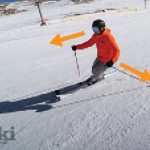
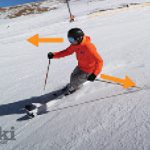
When controlling your edges through angulation, try to get your chin over the downhill foot. In reality it never actually gets that far, but the attempt helps to keep your balance on the outside ski as you tip your legs over.
Another more subtle sensation to associate with angulation is to lift your inside bum cheek as you’re bending the inside leg. It helps to keep the hips somewhat level, allowing the torso to stay more upright.
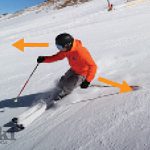
If you’re trying this bum-lifting thing in the living room as you read this (I know you are!), you’re probably receiving strange looks from your partner. Don’t worry! Just remember who’s going to have the last laugh on your next ski trip—and who’s still going to be skidding around the mountain.
